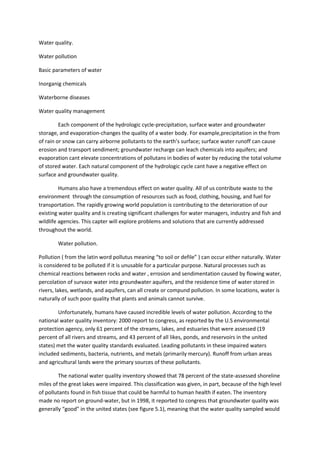Water quality
- 1. Water quality. Water pollution Basic parameters of water Inorganig chemicals Waterborne diseases Water quality management Each component of the hydrologic cycle-precipitation, surface water and groundwater storage, and evaporation-changes the quality of a water body. For example,precipitation in the from of rain or snow can carry airborne pollutants to the earthâs surface; surface water runoff can cause erosion and transport sendiment; groundwater recharge can leach chemicals into aquifers; and evaporation cant elevate concentrations of pollutans in bodies of water by reducing the total volume of stored water. Each natural component of the hydrologic cycle cant have a negative effect on surface and groundwater quality. Humans also have a tremendous effect on water quality. All of us contribute waste to the environment through the consumption of resources such as food, clothing, housing, and fuel for transportation. The rapidly growing world population is contributing to the deterioration of our existing water quality and is creating significant challenges for water managers, industry and fish and wildlife agencies. This capter will explore problems and solutions that are currently addressed throughout the world. Water pollution. Pollution ( from the latin word pollutus meaning âto soil or defileâ ) can occur either naturally. Water is considered to be polluted if it is unusable for a particular purpose. Natural processes such as chemical reactions between rocks and water , errosion and sendimentation caused by flowing water, percolation of survace water into groundwater aquifers, and the residence time of water stored in rivers, lakes, wetlands, and aquifers, can all create or compund pollution. In some locations, water is naturally of such poor quality that plants and animals cannot survive. Unfortunately, humans have caused incredible levels of water pollution. According to the national water quality inventory: 2000 report to congress, as reported by the U.S environmental protection agency, only 61 percent of the streams, lakes, and estuaries that were assessed (19 percent of all rivers and streams, and 43 percent of all likes, ponds, and reservoirs in the united states) met the water quality standards evaluated. Leading pollutants in these impaired waters included sediments, bacteria, nutrients, and metals (primarily mercury). Runoff from urban areas and agricultural lands were the primary sources of these pollutants. The national water quality inventory showed that 78 percent of the state-assessed shoreline miles of the great lakes were impaired. This classification was given, in part, because of the high level of pollutants found in fish tissue that could be harmful to human health if eaten. The inventory made no report on ground-water, but in 1998, it reported to congress that groundwater quality was generally âgoodâ in the united states (see figure 5.1), meaning that the water quality sampled would
- 2. support all designated uses. However, measurable negative impacts have been detected from leaking sources such as underground storage tanks, septic systems, landfills.


